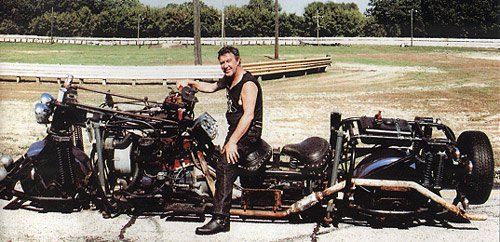-
Posts
629 -
Joined
-
Last visited
-
Days Won
2
Content Type
Profiles
Forums
Blogs
Events
Gallery
Downloads
Store
Everything posted by beermanpete
-
I can't say what the actual movement of the damper ring is but since timing accuracy is important I would not use the damper ring to trigger the ignition. You should mount the 36-1 wheel to the hub of the damper.
-
The boot may help increase the strut seal life by helping to keep water and dirt of the strut shaft but it is not necessary. Most cars do not have boots over the strut or shock shafts and seal life is generally acceptable.
-

Brake warning switch
beermanpete replied to letitsnow's topic in Brakes, Wheels, Suspension and Chassis
I suspect what you feel is the master cylinder piston for the side with low pressure bottoming out when the pressure drops too much. The warning light switch is not part of the master and I doubt you would be able to feel its operation in the brake pedal. Perhaps the master cylinder is leaking internally. Does the the pedal sink if you hold steady pressure on it for a while? -
You have a 3-wire tach. What year is your car? I am under the impression that the early cars (with points) came with the 4-wire tach. Perhaps someone has modified your car to use the later tach (or some early models came with the 3-wire tach). Either way, the wiring diamgrams I have for the 72 and 73 do not apply. The 3-wire tach senses the engine speed on the negative side of the coil. The single yellow wire on the tach should be sensing wire and goes to the negative side of the coil. The other 2 wires are +12 (yellow/red) and ground (black). You should be able to trace the sense wire from the tach down to the igniton harness near the coil with an ohmmeter or buzz box. The power and ground wires most likely do not go into the engine compartment. Verify that power is present with the key on and the ground is solid.
-
You should look at the wires at the tach and the ignition switch. It sounds like the wiring has been worked on in the past. Maybe someone made a mistake repairing it or cross-connected something.
-
I never saw any splices in the wiring on my '73. Are you disconnecting all the wires while you test to see when the voltage is present at each? If you test it with the wiring connected to the ballast and coil you will get misleading results. Is you car running now? Does the tach work?
-

Loose wires in my 240, what are they for?
beermanpete replied to Laurel1800's topic in S30 Series - 240z, 260z, 280z
-
One of the black/white wires comes from the ignition switch to power the ignition system. This is the one that should be +12V with the key in both the ON and START positions. The green/white wire goes from the ballast to the tach AND to the ignition switch. In the START position it gets connected to the +12V circuit, effectively shorting out the ballast. This helps the car start easier by providing a hotter spark. The other black/white wire comes from the tach to the coil + terminal. The black wire should go from the coil - terminal to the distributor. Since you have the Pertronix system installed this wire may have been removed. The manual shows a black/yellow wire for the throttle opener solenoid. Perhaps they have been mixed up? It is possible the color codes in the manual do not match the car due ot a mistake in the manual or a producution change in the cars.
-
The 73 tach is the 4-wire type. The tach senses the ignition current pulses in the positive side of the primary circuit. Unless you significantly rewired the ignition and tach cicuit, you need to use the 3 original wires on the positive side of the coil. There are 2 black/white wires and a green/white wire. If you reverse the 2 black/white wires the car will run but the tach won't work. To identify which black/white wire is which: 1) Remove all 3 wires from any terminal at the coil and ballast resistor. 2) Test for voltage at each wire with the key in the ON and CRANK positions. 3) One black/white wire will have +12V when the key is in the ON and CRANK positions. Connect this wire to one end of the ballast resistor. 4) The other black/white wire will only have voltage in the CRANK position. Connect this wire to the positive side of the coil. 5) Connect the green/white wire to the other terminal on the ballast resistor. 6) Connect the red wire from the Pertonix to the black/white wire on the ballast resistor. If you are not using the ballast resistor, connect the black/white wire identified in step 3 to the green/white wire.
-

Only clicks and no spark?
beermanpete replied to mistah mofro's topic in Trouble Shooting / General Engine
Your non-cranking is likely due to voltage drop in the wiring. Check the connectors, ignition switch, and so on. Also, there is no fuse in this circuit, only the fusible link at the starter. An overload in the ignition wiring could drag the voltage down and prevent the solenoid from pulling in. Make sure the wiring at the coil and ballast resistor is correct. -

No power to starter/Ground issue?
beermanpete replied to Med Center Z's topic in Trouble Shooting / General Engine
Yeah, it sounds like the engine is locked up. Too bad about that. If you could turn the harmonic dampener separately from the crankshaft when the screw was only 4 turn out the woodruff key is likely missing. You should check on that. -
Yes, a short will have continuity to ground. From your description it sounds like it could be a bad connection somewhere. You have voltage without a load (lights off) and when you turn on the lights the voltage falls due to the load. This seems to suggest a high resistance (bad connection) upstream. Check the fuses, fuse connections, connectors, switches and so on. Probe the circuit along the path moving from the point you know has the voltage drop, moving toward the battery, until you find the point that still has 12 volts. The first component or connection past (on the load side) that point is the likely suspect.
-

No power to starter/Ground issue?
beermanpete replied to Med Center Z's topic in Trouble Shooting / General Engine
1) Your wiring probably has VD (voltage drop.) Try jumping the battery directly to the solenoid terminal. If it cranks easily then your wiring has one or more bad connection in the starting circuit. 2) Typically there are 2 wires on the battery negative terminal. The 4-gauge wire that goes to the engine block and a 10-gauge wire that connects to the firewall to ground the car body. The positive terminal only has the 4-gauge wire that goes to the starter motor. -

overheat-rpm slowly falls now wont start
beermanpete replied to IneedAmotor's topic in Trouble Shooting / General Engine
Check the fan belt. -

Please help me identify what needs replacing! Gnarly Gear Grinding
beermanpete replied to MazerRackham's topic in Drivetrain
MSA has the nylon bushings. There are brass, aluminum, and nylon bushing on E-bay. Some people have used door hinge pin bushings. These are available at most auto part stores. Some minor mods to the bushings are required but the price is less. -
The return line has a 0.043" diameter metering orifice at the end of the fuel rail.
-
-

Steering Shaft Play in column
beermanpete replied to Lazeum's topic in Brakes, Wheels, Suspension and Chassis
The upper shaft is held in with a snap ring that is behind the steering wheel. After you remove the steering wheel and the combination switch you will see a cone behind the splines for the steering wheel. The cone is split and held in place with a wire spring clip. Remove the wire clip and cone. Now you should see a snap ring. Remove the snap ring and the upper shaft will slide out the back of the shaft housing. You can clean and inspect the bearings, splines, and the spring. Make sure the spring has the proper free length and that it requires some compression to install the snap ring. The spring tension keeps the bearings from having free play. -

Changing wheel offset
beermanpete replied to veritech-z's topic in Brakes, Wheels, Suspension and Chassis
Try Bogart Racing Wheels: http://www.bogartracingwheels.net/ -
Bowl vents. Dang, Leon beat me to it
-

Do the bearings in an R200 differential need to be greased?
beermanpete replied to RebekahsZ's topic in Drivetrain
The factory service manual suggests to use gear oil on the bearings and pack grease into the cavity between the lips of the grease seals. -
Ours did the same thing. Corrosion and varnish were preventing easy movement. I was able to remove the jet nozzles while the carbs were on the engine and clean them with a ScotchBrite. Now they move easily and the choke returns all the way.
-
Most fuses will blow after about 1 hour if operated at rated current. Here is the Littlefuse specification for the blade style automotive fuses. http://www.littelfuse.com/data/en/Data_Sheets/Littelfuse_BladeFuse_ATO32V.pdf You also need to allow for surge currents that occur at start-up. Motors, lights, and many other loads draw many times the running current for a moment when power is applied. Install the fuses as close to the power source (battery) as practical. You need to protect the wire run as well as the load.
-
The field winding is in the alternator. It is connected to the regulator through the 2-pin connector on the back if the alternator. Look in the factory service manual for details. You can get a copy for free at http://www.xenons30.com/reference.html.

